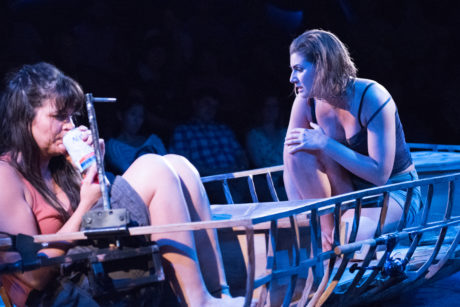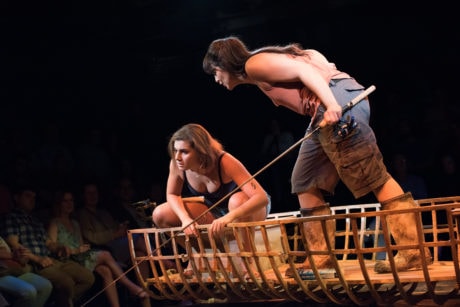One measure of the quality of a play is how it stays in one’s mind the next few days. Or the next weeks or months or years. Not just how it plays on stage. How it remains in the brain.

There are no awards for this quality. No Tonys for most memorable. No Helens or Hayeses for most enduring experience in live theater. Nor has anyone (to my knowledge) surveyed theatergoers to find out what feelings they remember that were occasioned by a show they saw. That’s not really possible, of course. Emotional recollection like that is subjective. It says less about the play than about the individual remembering it.
Or does it?
I ponder this by way of reflecting on the world premiere production of Audrey Cefaly’s beautiful play The Gulf that I just saw at Signature Theatre. I’ve got a hunch it will hang around in my mind. And I’ve got a clue as to why.
I read the script of The Gulf several weeks ago before having a wonderful conversation with Audrey, which was published with a title lifted from something she said: “I Think About How Badly I Can Break a Heart Today.” As I reread that Q&A after seeing The Gulf in performance, one passage jumped out at me afresh:
I focus on two-handers, character-driven narratives. They are all love stories. All of them. I construct them and distill them in such a way that the audience can let go and focus on the sounds and the vibrations. It’s heavy on tension, low on sentiment. Those are the kinds of plays that pull me in, so those are the ones I like to write. We see ourselves in the characters, not because we recognize them, but because we recognize the ache.
Recognizing “the ache” describes what happened for me when I saw Audrey’s Maytag Virgin, and exactly what happened for me when I saw The Gulf.
The Gulf is about two women named Betty and Kendra (sublimely played by Maria Rizzo and Rachel Zampelli). Though Betty and Kendra have been lovers for six years,The Gulf is not a lesbian play per se. By which I mean each character’s “ache” is recognizable and relatable in ways that defy simplistic categorization.

Betty and Kendra are afloat in a boat in shallow waters of the Alabama delta. The story is set with water water everywhere—an unsolvable staging challenge unless you’re Cirque du Soleil—but the scenic, lighting, and sound design (by Paige Hathaway, Andrew Cissna, and Kenny Real, respectively) make it all plausible as possible. What’s most important is that the stage arts not get in the way of our experience of the characters’ emotions —and in that The Gulf is well served. Director Joe Calarco’s astute choice to mount the play in the round ensures that the feelings we sense in each moment are up-close and personal as can be.
Betty and Kendra are in a boat because Kendra likes to fish and Betty, who doesn’t, wants to be with her. Betty, who intends to go away to community college to become a social worker, has brought along a self-improvement book, What Color Is Your Parachute? Initially Betty tries to persuade Kendra to set her sights on a better job than the menial-labor one she has and come with her. Kendra doesn’t want to be improved or made to change and doesn’t want to move. It’s all very funny, full of Cefaly’s priceless one-liners, but from the outset there are tensions in their relationship ready to flare any second.
There is palpable eroticism between Betty and Kendra pulling them together (as their scenes of passion make plain). Yet there are divisions between them that push them apart. “Could we be more different?” Kendra asks Betty at one point.
What happens when viewing The Gulf is that we are swept into the undercurrents of what is fundamentally a very universal love story. Two people are in love, but they are two different people—as how could two people not be? So how over time do they reconcile what unites them with what individuates them? How does love survive the lovers themselves?
It’s a story as old as time, right? But somehow Cefaly tells it anew. With a gift for writing characters whose hearts and hurts are opened to us in beautiful, bold, breathtaking, and ultimately healing ways.

Some who sense this undercurrent will want only to wade in, which is fine. Some may be towed under and engulfed. But it’ll always be the underlying aching that will lure us and linger.
Audrey Cefaly’s The Gulf is as memorable as anyone’s own first broken heart and as enduring as anyone’s longing for lasting love.
You can dive into it now at Signature.
Running Time: Approximately 80 minutes, with no intermission.
The Gulf plays through Sunday, November 6, 2016 at Signature Theatre – 4200 Campbell Avenue, in Arlington, VA. For tickets, call (703) 820-9771, or purchase them online.
LINKS:
Magic Time! “I Think About How Badly I Can Break a Heart Today”: A Q&A with Audrey Cefaly, Author of ‘The Gulf’ at Signature Theatre by John Stoltenberg.
Review: ‘The Gulf’ at Signature Theatre by David Siegel.
RATING:




